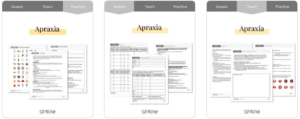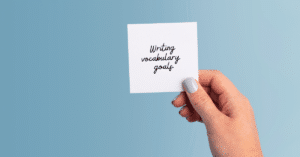This blog post discusses how to write goals for childhood apraxia of speech (CAS) for speech language pathologists.
What is Childhood Apraxia of Speech?
Childhood apraxia of speech (CAS) is a motor speech disorder that falls under the umbrella of speech sound disorders.
Childhood apraxia of speech (CAS) occurs when motor movement and planning is impaired, which results in errored speech sound production. When a child has apraxia of speech, it impacts the precision and consistency in their speech, and is not due to muscles working incorrectly (ASHA, 2007b).
What are the Characteristics of Childhood Apraxia of Speech?
According to ASHA, the following 3 characteristics are typically agreed upon across studies as being connected to childhood apraxia of speech:
1. Inconsistent errors on consonants and vowels in repeated production of syllables/words
2. Lengthened/disrupted coarticulatory transitions between sounds and syllables
3. Inappropriate prosody
Other characteristics noted are articulatory groping, increasing difficulty with longer/complex words, and vowel errors.
How is Childhood Apraxia of Speech different from a Phonological Disorder?
Determining if a child has childhood apraxia of speech or a phonological disorder can be tricky, because a student can show characteristics of both. However, there are a few ways to distinguish between the two.
Characteristics often seen in Childhood Apraxia of Speech
· Restricted sound repertoire
· Poor differentiation of vowels
· Few/simple syllable shapes
· Atypical error patterns (e.g. initial consonant deletion, voicing errors, epenthesis)
Characteristics often seen in Phonological Disorders
· Consistent patterns of error (think fronting, stopping, etc.)
· Intact prosody
· Vowels intact
There is evidence to support that many children with childhood apraxia of speech will have co-occurring problems. This means a thorough evaluation is necessary for our speech students with CAS or suspected of having CAS (Lewis et al., 2004).
How to Write IEP Goals for Speech Students with Childhood Apraxia of Speech
To start, let’s discuss goals we shouldn’t target when it comes to childhood apraxia of speech. It is not recommended to target nonspeech exercises, for example, tongue strengthening exercises (McCauley, Strand, Lof, Schooling, & Frymark, 2009). Remember, apraxia is a motor movement-based disorder and is not due to muscle weakness.
When thinking about childhood apraxia of speech goals for IEPs and plans of care, consider the following 3 areas (Stoeckel, 2018):
1. The student’s inventory, such as single syllables, varied syllable shapes, syllable sequences, and sound development.
2. Identify functional vocabulary needs and compare to the student’s inventory.
3. Be aware of typical speech sound development.
Like all speech IEP goals, the IEP goals you write for childhood apraxia of speech should be specific to the speech student. Pay attention to the types of cueing that create success for your speech student.
Need a refresher on goal writing? Click here to learn more about how to write SMART goals.
3 Goal Examples for Childhood Apraxia of Speech
Childhood Apraxia of Speech Goal Example 1: Producing syllable shapes.
Given a direct model, Student will produce CVC and CVCV syllable shapes using existing and emerging sound inventory, given visual and tactile prompts, with 70% accuracy.
Example: If a student has /m/ in their inventory, but not CVC or CVCV syllable shapes, “mom” or “mommy” could be a functional target for this goal. Don’t forget to consider vowel inventory when selecting targets!
Childhood Apraxia of Speech Goal Example 2: Increase syllable shape repertoire.
Given visual, verbal, and tactile models, Student will increase syllable shape repertoire by producing 5 new CV and CVC words using acquired consonants and vowels with 80% accuracy across three consecutive sessions.
Example: If a student has /m, p, d/ in their inventory, targets could include “ma”, “mom”, “dad”, “pa”, “pop”, etc.
Childhood Apraxia of Speech Goal Example 3: Combine existing syllable shapes.
Student will combine 2 existing syllable shapes that include existing sound inventory, provided no more than 1 visual and verbal model, in 8/10 opportunities across three consecutive sessions.
Example: If a student can say “my” and “mom”, prompt the student to produce “my mom.”
>> Need more examples of IEP Goals for your students? Check out our comprehensive SLP Goal Bank!
How to Target Childhood Apraxia of Speech Goals with Speech Therapy Students
Treating speech students with childhood apraxia of speech (CAS) can feel overwhelming, so it is important to remember that there is a ton of research to help us feel more confident! SLP Now has research-backed materials that help guide your treatment of childhood apraxia of speech.

Dynamic Assessment
By completing a dynamic assessment for apraxia of speech with your speech student, you’ll figure out which stimulus set to start with during speech therapy.
During the dynamic assessment, you will have the student attempt a variety of syllable shapes to see which movements are difficult for them to produce. Examples of syllable shapes include CV, VC, CVC, and multisyllabic words. Remember, apraxia is a motor-based speech disorder, so the focus is on the breakdown on the speech student’s motor planning.
Choose Your Initial Stimulus Set for CAS
Once you’ve completed a dynamic assessment with your speech student, you can now select a stimulus set to target with your speech student with childhood apraxia of speech.
For speech students with severe CAS, choose a small stimulus set, and provide frequent feedback for accurate productions.
It is very important to include words that are important to the client and their family!
Determine the Treatment Method
Below are treatment methods to consider when treating a student with childhood apraxia of speech:
→ Dynamic Temporal and Tactile Cueing DTTC (Developed by Edythe Strand)
→ ReSt/TEMPO (Developed by Speech Pathology in the Sydney School of Health Sciences at the University of Sydney headed by Professor Tricia McCabe)
→ Integrated Phonological Awareness Training (Moriarty & Gillon, 2006)
→ The NDP3 program (Williams & Stephens, 2004)
Click here for a more in-depth walkthrough of how to treat childhood apraxia of speech during your speech therapy sessions.
This is a guest blog post from Rachel, a virtual school-based speech-language pathologist, discussing how to write childhood apraxia of speech (CAS) goals for speech therapists!
Childhood Apraxia of Speech References
American Speech-Language-Hearing Association. (2007b). Childhood apraxia of speech [Technical report]. Retrieved from www.asha.org/policy/
Lewis, B. A., Freebairn, L. A., Hansen, A. J., Iyengar, S. K., & Taylor, H. G. (2004). School-age follow-up of children with childhood apraxia of speech. Language, Speech, and Hearing Services in Schools, 35, 122–140.
McCauley, R. J., Strand, E. A., Lof, G. L., Schooling, T., & Frymark, T. (2009). Evidence-based systematic review: Effects of nonspeech oral motor exercises on speech. American Journal of Speech-Language Pathology, 18, 343–360.Stoeckel, Ruth. (2018). Building and Expanding Your CAS Toolkit. ASHA. https://learningcenter.asha.org/diweb/home




Reader Interactions